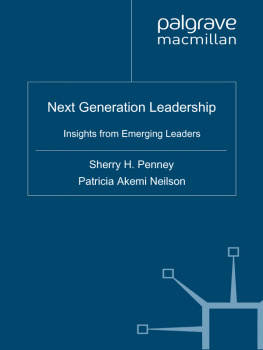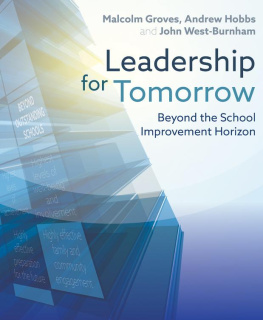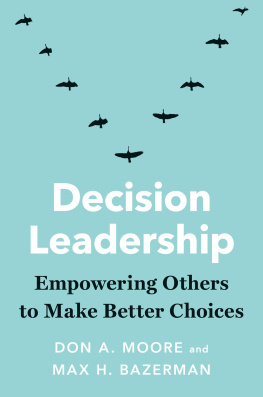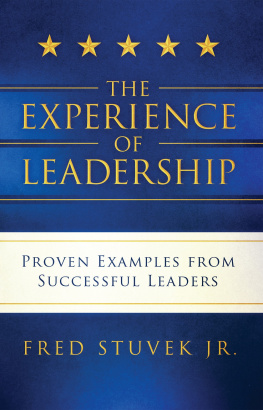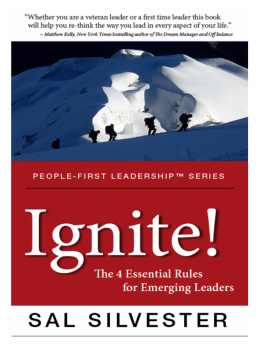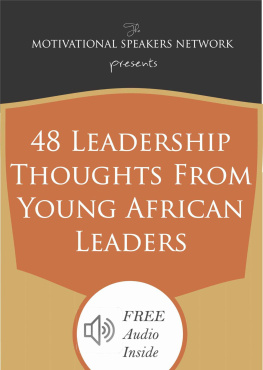NEXT GENERATION LEADERSHIP
INSIGHTS FROM EMERGING LEADERS
SHERRY H. PENNEY AND PATRICIA AKEMI NEILSON


NEXT GENERATION LEADERSHIP
Copyright Sherry H. Penney and Patricia Akemi Neilson, 2010.
All rights reserved.
First published in 2010 by
PALGRAVE MACMILLAN
in the United Statesa division of St. Martins Press LLC,
175 Fifth Avenue, New York, NY 10010.
Where this book is distributed in the UK, Europe and the rest of the world, this is by Palgrave Macmillan, a division of Macmillan Publishers Limited, registered in England, company number 785998, of Houndmills, Basingstoke, Hampshire RG21 6XS.
Palgrave Macmillan is the global academic imprint of the above companies and has companies and representatives throughout the world.
Palgrave and Macmillan are registered trademarks in the United States, the United Kingdom, Europe and other countries.
ISBN: 9780230620698
Library of Congress Cataloging-in-Publication Data
Penney, Sherry H.
Next generation leadership : insights from emerging leaders / Sherry H. Penney and Patricia Akemi Neilson.
p. cm.
Includes bibliographical references and index.
ISBN 9780230620698
1. Leadership. I. Neilson, Patricia Akemi. II. Title.
HD57.7.P447 2010
658.4092dc22
2009036638
A catalogue record of the book is available from the British Library.
Design by Newgen Imaging Systems (P) Ltd., Chennai, India.
First edition: June 2010
10 9 8 7 6 5 4 3 2 1
Printed in the United States of America.
To Emerging Leaders Everywhere
FOREWORD
THE TIME FOR NEW LEADERSHIP IS NOW, AND WE ARE PLEASED TO SEE THE hopeful messages conveyed in the chapters that follow. This book looks at leadership from the viewpoint of emerging leaders themselves. How do those who will lead see the future challenges to leadership? What goals do they have, what skills will they need, and what kinds of organizations do they want to lead? In this book, we also hear about the leadership aspirations of women and people of color, and the need for cultural awareness in institutions.
We speak as individuals from the private and the nonprofit sectors who have been in leadership positions and observed leadership in many forms. We both have been privileged to have met and worked with many of the over three hundred emerging leaders discussed in this book. We find them to be talented and inspirational. Leaders everywhere will benefit from their insights.
We urge you to read this book and learn what young leaders have to say about leadership for the future. The next generation of leaders is already among us. Our future is in their hands, and we ignore them at our peril. We must heed their voices now because leadership for the future cannot be left to chance. It is time to pass the torch.
Marshall N. Carter
Chairman, New York Stock Exchange Group
Chairman and CEO (retired), State Street Corporation
Hubie Jones
Dean Emeritus, Boston University School of Social Work
Founder and President, Boston Childrens Chorus
Charter Trustee, City Year, Inc.
AUTHORS NOTES
SHERRY H. PENNEY
It is perhaps presumptuous to think that anyone can actually teach leadership. So when I thought about offering courses in leadership and also establishing a unique executive leadership program late in my career, I reviewed my own evolution as an academic, civic, and business leader. What in my own values and experiences informed me and propelled me on this journey? Why did I want to establish an Emerging Leaders Program?
My values like those of many others come from my parents, and for me, my Dads influence, in particular, was the formative event for my journey in and of leadership. It is a journey that involves values, experiences, and seeing a strong need. My father, Terry Hood, was a school principal and superintendent in Michigan while I was growing up and was the ultimate collaborative leader although such a concept was not used in the 1950s. As a school administrator, his values were an essential part of all that he did. He was attuned to issues of diversity although we rarely discussed it. He invited a black choir to our small town in Michigan to sing at our all white church. Our community was predominately white and quite conservative, but he was totally committed to justice and equality, and to seeing the best in everyone and believed that others should try to be this way too. There were gay and lesbian teachersindividuals whom he hired because they were outstanding teachers. I never heard him use words such as diversity, but he lived in such a way that it was evident that he valued all individuals equally and tried to foster in others an attitude of openness and acceptance.
He never allowed me to believe that there were any limitations to what women could do, and when at age 11, I announced that I wanted to be a lawyer, he encouraged that goal. (My mother told me I should train to be a teacher.) Later in my teens, he arranged for me to meet the congresswoman from Michigan, Martha Griffiths. Again, he placed no limits on what I might want to do. He supported equal educational opportunity for all and that is how he lived his life. When he was felled by a heart attack at a young age, he gave up administration and became a high school counselor and continued his commitments to helping all without regard to race, gender, or difference.
I pursued a pre-law curriculum as an undergraduate but ended up enrolling in graduate school with a generous scholarship rather than law school and set out to become a history professor. (History was also the discipline that my father taught before he became a principal.) As a doctoral student I was told, as discussed in , that my university would never hire a woman in its history department, although the department would help me find a job elsewhere. I did not protest but listened carefully and probably from that moment on, I knew that I would find a way to see that no other woman ever had to hear those words. That I would strive to become a university president might have been ordained that day!
After graduate school, I taught history briefly at Union College in Schenectady, New York, but moved into administration soon after. I was fortunate to serve as associate provost at Yale University and vice chancellor for Academic Programs at the SUNY system office and acting president of SUNY Plattsburgh before becoming chancellor of the University of Massachusetts Boston. As chancellor, I occupied a major leadership position and tried to be the collaborative leader that I hoped to be. Im sure all did not see it that way!
I also made real my commitment to diversity, and my senior staff of vice chancellors and deans included more women and people of color than white males. Moreover, during my tenure we added the Asian American Institute and the Gaston Institute (for research on Latinos) to the Trotter Institute for African American Studies that existed on the campus prior to my arrival. We also made a home for the Institute for Women and Politics whose goal is that more women run for and be elected to public office.
The university faced 11 budget cuts and reversions in my first four years on the job and the reaction in the university community was one of anger and disbelief. My attempts at collaboration worked sometimes better than others. One of the best was the formation of an inclusive committee to assist in making recommendations for the many reductions that had to be made. Together we learned much about collaborating to make difficult decisions.

